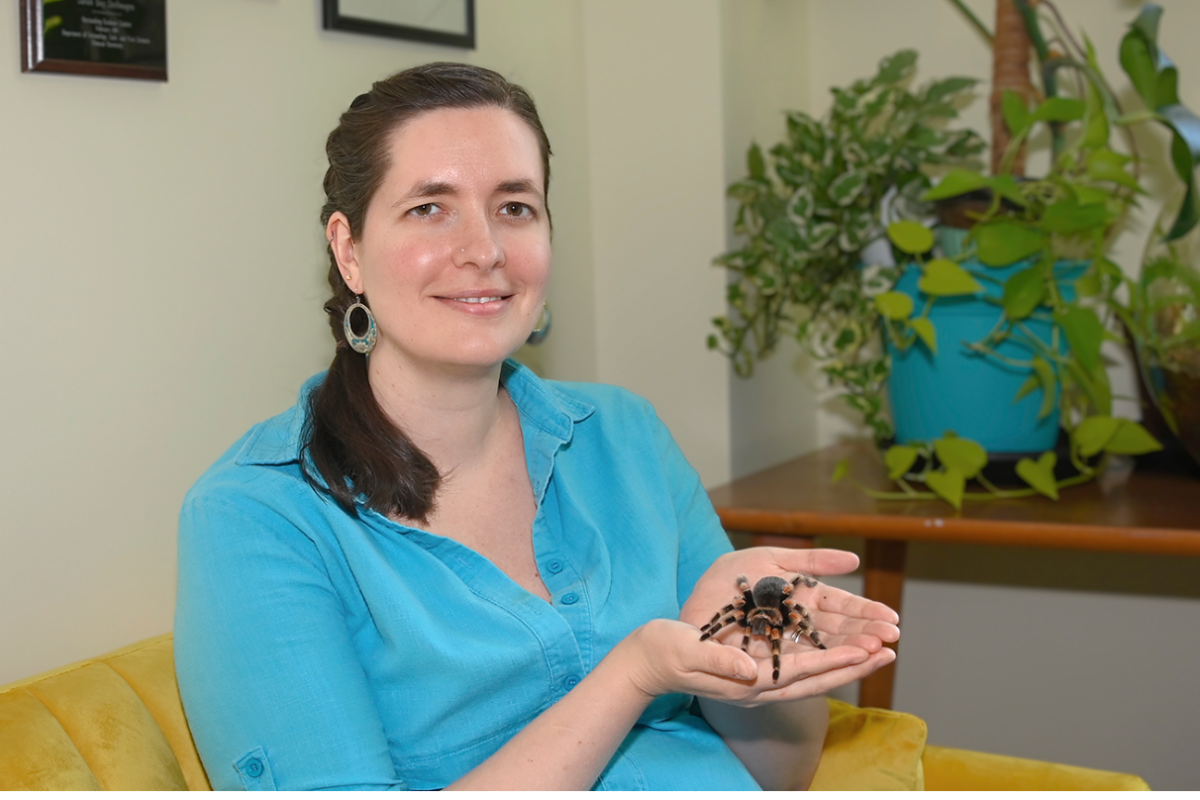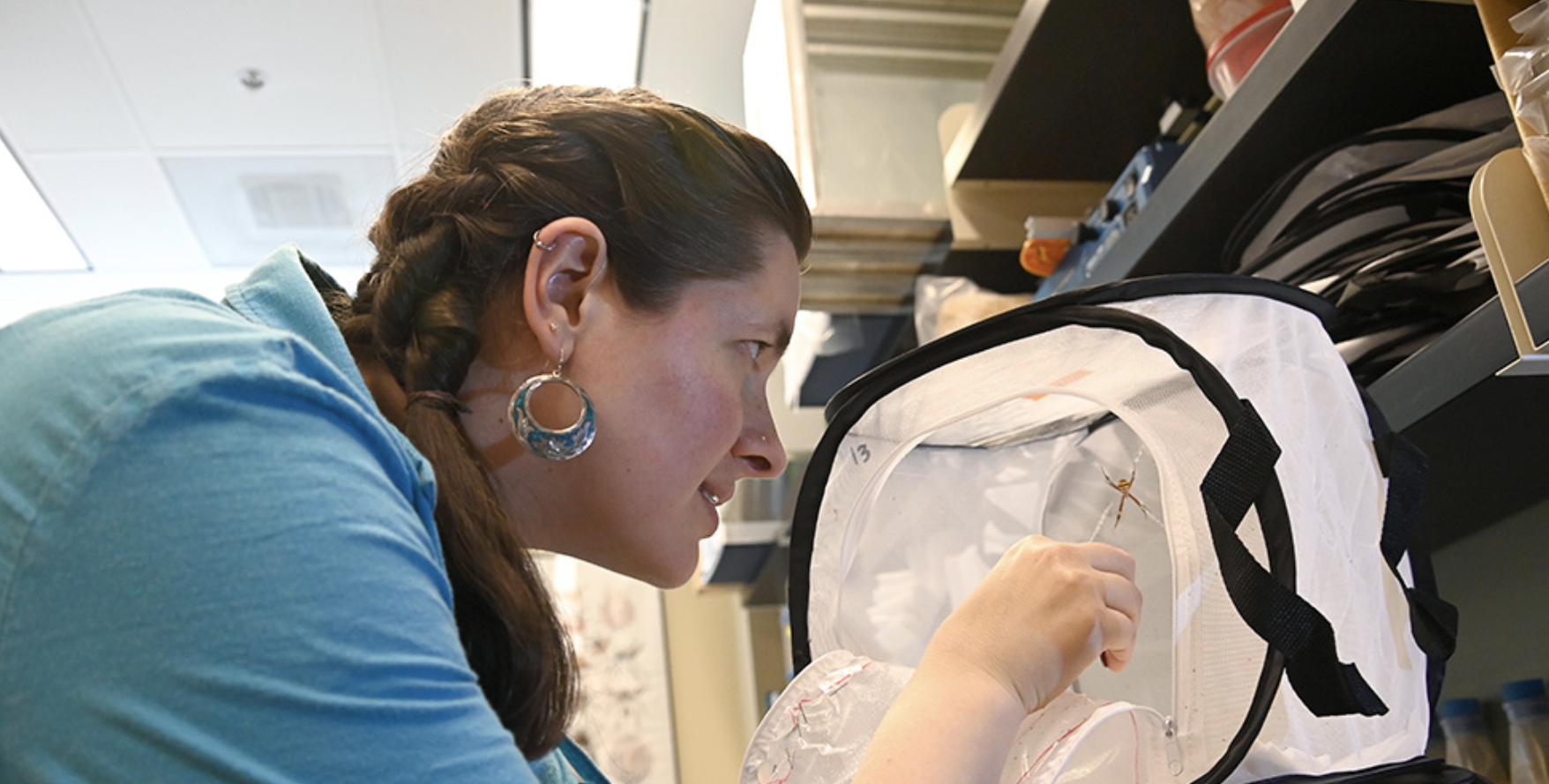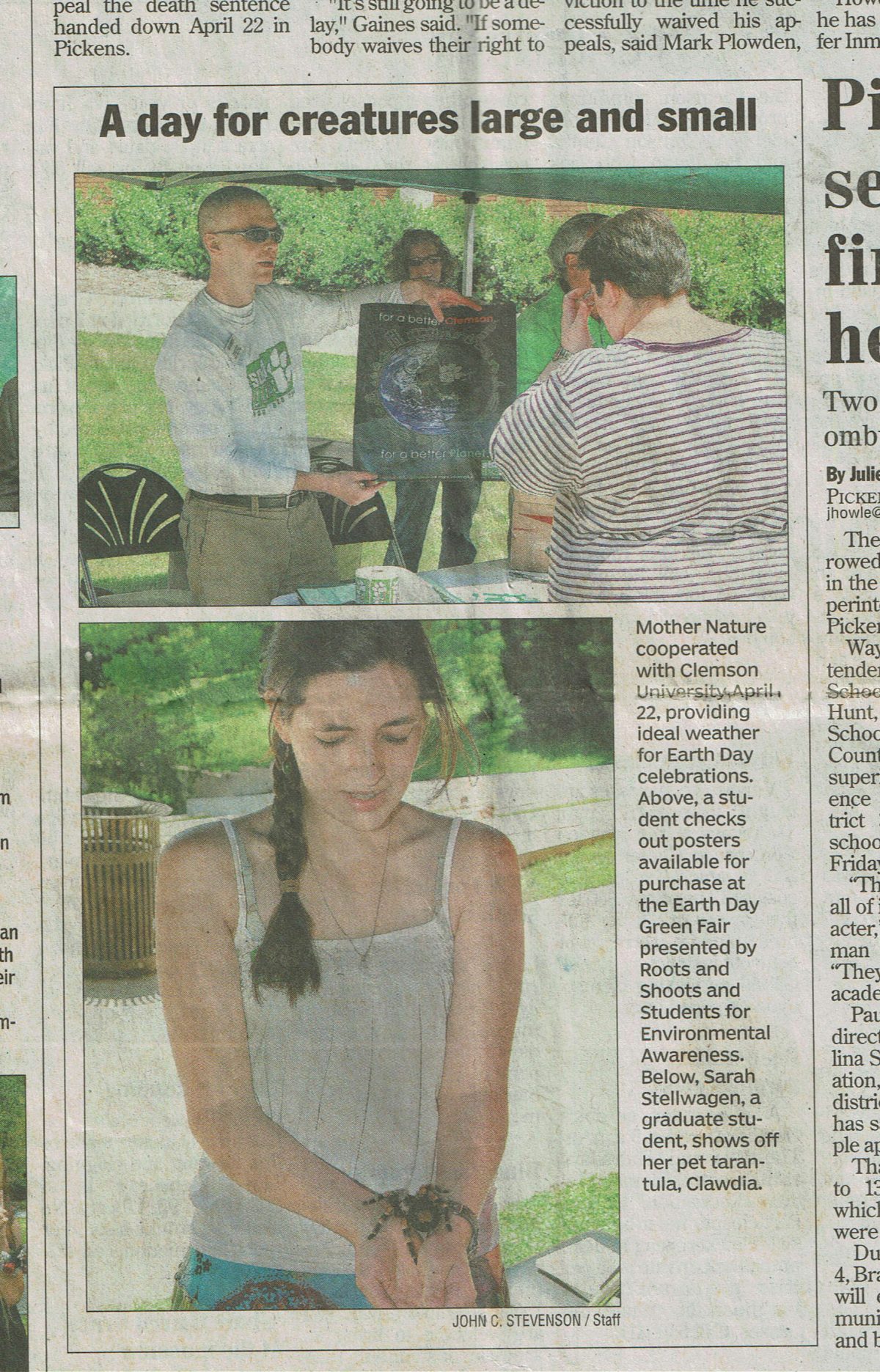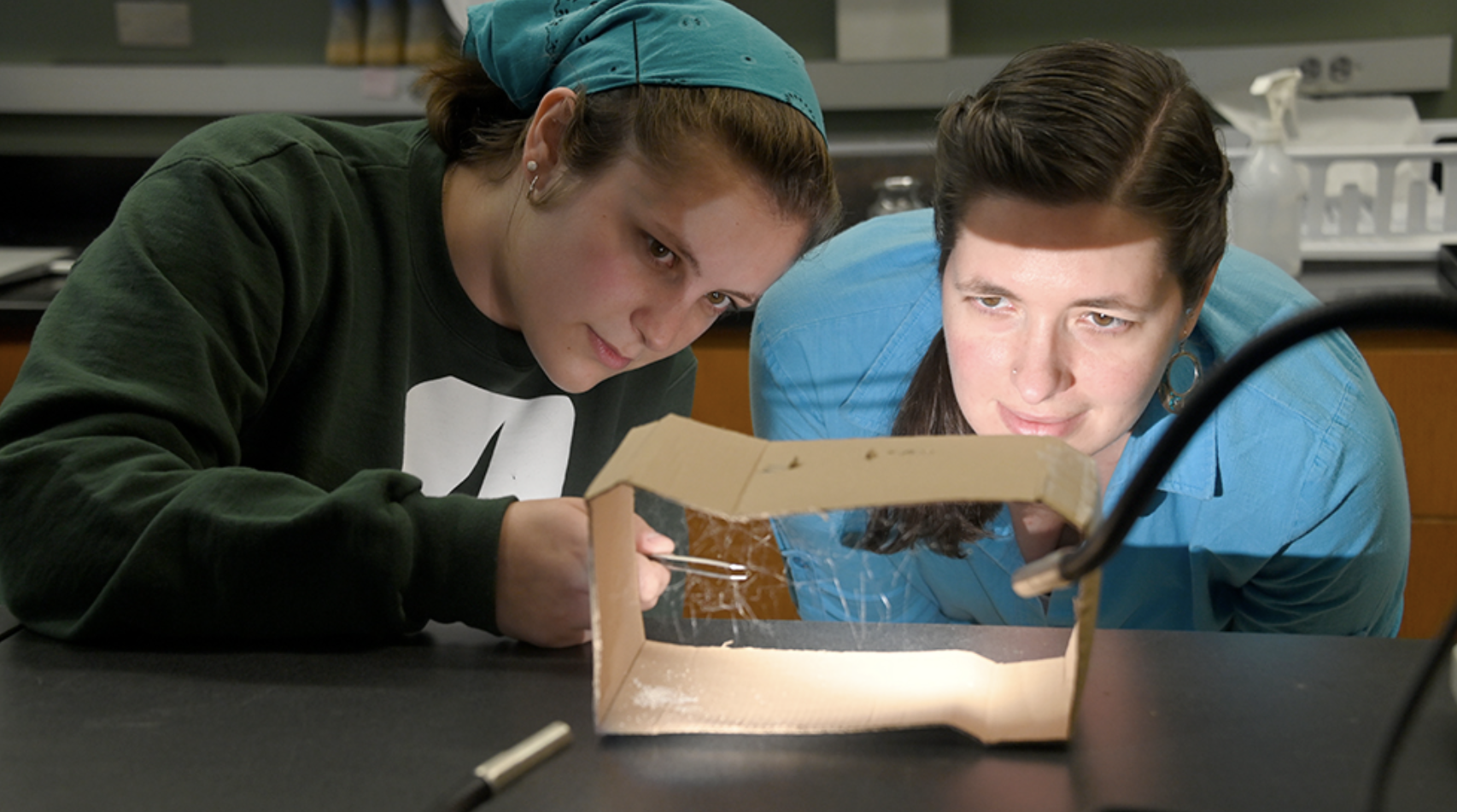
Sarah Stellwagen, assistant professor of biological sciences, has loved animals since she was little. “I had all numbers of pets when I was a kid. I had a small parrot at one point, ferrets and bunny rabbits. I had hermit crabs and snakes and I loved them all,” she said.
But it was a spider she spotted as a pre-teen in a pet store that ended up shaping her career.
ENTANGLED IN A PASSION FOR SPIDERS

Stellwagen examines a live spider in her lab that she collected from a recent trip to Australia.
Stellwagen recalls seeing the spider at age 11 like it was yesterday. “I saw a full-grown spider, and I felt like I just had to have that tarantula. I marched up to my mom and said ‘I’m buying that tarantula with my own money,’ because I had some Christmas money, and the spider was $39.99,” said Stellwagen. Her mother replied as many parents would: They would absolutely not be coming home with a spider for a pet.
She begged, and Stellwagen’s mother eventually caved, so they brought the tarantula — now named Stanley — home. Stellwagen and her mother began their research to learn all about caring for tarantulas and realized that Stanley was a female.

Stellwagens’s lab partner is “Sir Rambo” as named by the students, but Stellwagen suspects at this stage of development that this tarantula may be a female, as determined by the “palps” or front pair of leg-like structures.
Sadly, a few months later Stanley took a tumble when Stellwagen was handling her. “She died a few days later and my mom — who had learned all about the spider with me and originally said ‘no’ — cried over this big, bumbling spider that she had learned to love too.”

Front page news: Stellwagen showcased Clawdia for Earth Day in 2009 as a first-year master’s degree student at Clemson University. The Greenville News, April 28, 2009.
The next time around it was her mother’s idea to get a spider, and for Stellwagen’s 12th birthday she was given a baby tarantula she named Clawdia. Stellwagen later asked her mom why she finally acquiesced to allow a pet spider in their home. “She told me, ‘You can be into all kinds of things that maybe I didn’t approve of, but you wanted a spider and maybe that wasn’t such a bad thing to nurture,’” Stellwagen recounted.
Stellwagen’s mother continued to nurture her love of spiders into adulthood. “I didn’t really know that I could study spiders as my job until I got to college, and I had to choose a minor. Entomology and psychology were the two minors that fit into my schedule, and my mom said, ‘You are taking entomology,’ and I was like ‘Alright mom, whatever,’ but I took it, and I was hooked,” said Stellwagen. Her mothers’ intuition was right and entomology turned into Stellwagen’s passion.
She got through her college career with her spider by her side. “I had Clawdia for 17 years, so I had her longer than any other pet. She died just a couple months before I defended my Ph.D. dissertation. The timing was tough, and I sobbed like a baby when she died,” said Stellwagen. “This spider led me down the path of research into spider silk and glue that I am on today, studying it professionally and going to cool places around the world to study these fascinating creatures.”
THE SCIENCE THAT STICKS
Stellwagen’s research is supported through a National Science Foundation grant to study bioadhesives. Bioadhesives are glue — the substances that make silk and spider webs sticky, the slime a glow worm produces to help glide through the moss it inhabits, or the glue a velvet worm shoots out to trap a meal. Predators use their glue in different ways and understanding more about them could lead to advancements in pest control, adhesives, rope or other fibers.
The unique properties of silks make studying them incredibly difficult, as we have yet to replicate how liquid protein inside a spider turns into solid, yet stretchy, fiber as it travels down tiny ducts toward the outside of the spider. Stellwagen explains, this puzzle is why we are not yet able to use spider silks for clothing, the way we use domesticated silkworms to mass produce their harvested silk for apparel. Silk worms can be farmed together as vegetarians but predacious spiders would have to be housed individually.
Scientists will have to figure out how to make spider silk another way.
Each spider species makes various kinds of silk or glue for distinctive purposes with different physical or mechanical properties. Separate kinds of silk are used for a web’s frame, the radiating spokes, sticky spiral, prey wrapping, center web decorations, egg sacs or the attachment silk that connects a web to a surface.
The liquid silk is called dope while it is still inside the spider’s silk glands, and it gets ejected from a spider’s silk spigot — located on the spinnerets — in pairs, so each strand of silk is really two strands. The proteins in the dope line up within a gland’s duct to turn into a solid silk as it leaves the spider’s body. Glues also come in different types and are a modified form of spider silk protein that stays viscous.
One way Stellwagen examines spider silk samples is through a specialty sealed-environment box, built to her specifications by UNC Charlotte colleagues in mechanical engineering. The sample box allows for examination of glue or silk while controlling for humidity or temperature. The entire device is mounted on an air table that dampens external vibrations, so Stellwagen and her student researchers can manipulate the delicate samples while controlling for a specific climate.
“If we test a tropical glue in a desert environment, the data we get back won’t be meaningful. We have to regulate the temperature and humidity, so we put the samples in the environment in which they evolved to figure out baseline properties,” said Stellwagen.
The advanced environment-
Stellwagen’s mentor through her Ph.D. has a simpler version of the sealed-sample box she uses today, and she thought it could be expanded upon, but it presented some design challenges.
“My Ph.D. projects used his probing system, but it was much smaller and everything was very mechanical. You had to tighten the probe from the side and get everything lined up. He is a tinkerer and much more capable of building things himself, but I don’t have the skills to machine and assemble my own equipment. I went over to engineering to find someone to help me create this vision and take it a step further,” said Stellwagen.
The chamber enables researchers to directly measure force by keeping the probe stationary and maintaining the sample visually under the microscope while the entire box moves around the probe.
“It’s an absolute feat of engineering. Joe Dalton designed the probe to be able to swap out replaceable tips with a magnet. You have to use a new tip each time because if you reuse the probe tip on a drop of glue, you will contaminate the next sample. It takes time to regulate those climate factors inside the box, and if we had to keep opening the chamber to reload tips we would lose the environment and that is time limiting. So we keep the tips on a rack and have this whole system where we can now quickly change out probe tips without opening the box and losing the temperature and humidity settings. The probe measuring force is so sensitive that the weight of a few cookie crumbs will overload it.”
– Sarah Stellwagen
Outdoor temperatures and humidity can fluctuate significantly through any given day, and research has shown silks and glue perform differently in various combinations of conditions. The comparisons evoke food imagery: Glues increase in viscosity at lower temperatures, like how cold honey flows slower than when it’s warm. The properties of glue droplets on spider silk are greatly influenced by humidity — they can be very stretchy, like a long mozzarella cheese pull, or very sticky like a sugary icing that would require great force for something caught to pull away.
UNRAVELING THE MYSTERIES AND GENETICS OF SPIDER SILK
Stellwagen studies species native to our area and beyond, and the webs they construct are not all uniform. Cobweb spiders build scattered webs, constructed of a tangle of support and sticky gumfoot lines with no discernable pattern. Bolas spiders don’t weave webs, but instead hunt prey with a blob of glue at the end of a silk line, dangling it like bait at the end of a fishing pole. When an insect flying by gets caught in the glue, the bolas reels in the silk line to subdue its meal.
This spring, Stellwagen’s research took her to Australia to collect more specimens that use glues, including glow worms and a species of orb weaving spider. There is so little known about some creatures that researchers are still learning about basic aspects of their biology, like the life cycle of a species.
For the glow worms native to the North Carolina mountains, Stellwagen said, “We have bred some that we captured in the wild and had eggs hatch out months ago, but those babies are still larvae, and the hatchlings haven’t pupated into adults. Maybe it’s normal for them, but we don’t know if the cycle takes a year or if there are certain conditions needed to trigger that next stage. They live in high elevations and need it to be very wet at all times. It also gets cold in the mountains, so perhaps they feed through the summer, hunker down in the winter and have a longer life cycle.”
Stellwagen has been mapping spider silk genes for years hoping to unravel how different silks get their properties. This endeavor has proven to be cumbersome due to the length of these genes and the amount they repeat inside the sequence.
An average gene is roughly 1,350 DNA base pairs long, but spider silk genes are very large, ranging from 5,000 to more than 60,000 base pairs in bolas spiders. In typical gene mapping, researchers are able to take smaller portions of the DNA and extrapolate the information to line up the pieces for full mapping. In spider silk however, research has shown that long stretches of the DNA strand repeat. This makes it nearly impossible to sequence anything shorter than the full gene because it’s not possible to tell if a particular section of the gene is overlapping or repeating.
“It took me two years, and there were a few times I cried tears of frustration when my sequencing runs didn’t give me the data I needed. However, that Ied to me discovering the first spider silk glue genes that no one had been able to sequence before. It’s such a complex protein, and we have learned how big they are. Scientists have experimented to try to shorten the protein and put them into E. coli or yeast to study, but it’s complicated and the material properties of synthetic silks haven’t been the same. There is still a lot to discover in sequencing entire genes, and that technology we need is starting to catch up,” said Stellwagen.

Stellwagen and biological sciences student Ella Kellner examine some silks of the cobweb spider.
While the technology advances and the work continues, it’s Stellwagen’s turn to nurture the next generation of scientists. Stellwagen will be taking a group of students to the Highlands Biological Station for two weeks this summer.
The course, “Spiders of the Southern Appalachians,” will include extensive fieldwork to lead students in collecting and identifying spider species from the locally rich fauna in and around Highlands, North Carolina, and focuses on teaching students spider ecology and behavior.
“Everytime we offer this course there are biology students that come home and want to incorporate entomology and arachnology into their coursework. It’s certainly not for everyone, but for those who fall in love with it, the course can change the trajectory of their careers,” said Stellwagen.
Just like a tarantula did for Stellwagen, all those years ago.